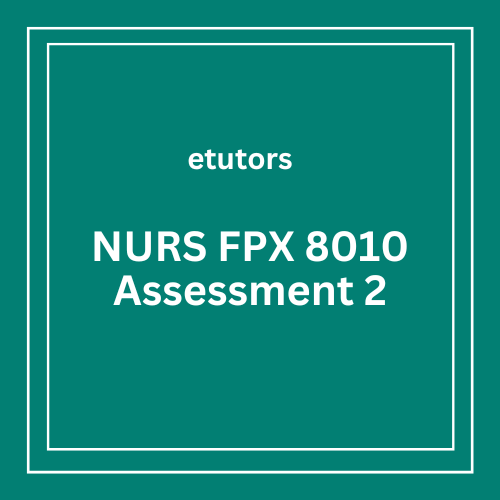Name
Capella University
NURS-FPX8010: Executive Leadership in Contemporary Nursing
Prof Name
September 2024
Strategic Plan Appraisal
A strategic plan is an organizational blueprint, showing its vision for the future and the priorities needed to achieve long-term success (Oh et al., 2019). The systems approach in analyzing an organization’s strategic plan requires critical thinking about how well the organization’s priorities fit with its mission and vision. Usually, these priorities are driven by internal performance measures and external comparison measures of patient satisfaction scores, readmission rates, or just another set of regulatory requirements. KPIs are key drivers in quality and performance by having some quantifiable measures to track the direction where the strategic objectives are being moved. For instance, within a healthcare provider setting, reducing hospital-acquired infections or improving patient outcomes may be critical objectives. These priorities should therefore be reflective of the larger organizational mission that includes great patient care, while the vision often points towards future growth, innovation, or community impact. Assessing the strategic plan from this perspective allows nurse executives and other leaders to ensure that the goals established within their department are aligned with the larger organizational direction, balancing short- with longer-term goals.
Strategic Plan Analysis
A comprehensive review of the strategic plan in an organization involves, for instance, the extent to which the identified priorities support the organization’s mission and vision (Niskala et al., 2020). Therefore, these priorities are often built on both internal needs and environmental considerations. For instance, if the mission of an organization emphasizes a patient-centered approach to care, strategic priorities would focus on improved outcomes for patients, fewer medical errors, and better-coordinated care. The vision, normally the long-term aspirations of the organization, usually fuels initiatives aimed at promoting innovation and growth along with positive community impacts. Reconciliation between the strategic plan and the mission and vision of the organization makes sure that the organization gets to be on both current operational objectives and long-term objectives.
Most healthcare organizations align their strategic priorities with better quality of care, operational inefficiencies, and regulatory compliance in the name of innovation. Usual measures for measuring success are patient satisfaction scores, financial viability, and employee engagement. These metrics are even more essential in determining whether strategic initiatives help in keeping the mission of delivering affordable quality care (Weston, 2020). This puts the organization in a better position to adapt to industry changes, thus ensuring growth in sustainability and patient care excellence.
Validity of Data and Analytical Strategies
Validating the data and analytical strategies used in finding out the direction of organizational priorities will ensure that all decisions made are evidence-based and focused on organizational goals (Popenoe et al., 2021). Healthcare organizations normally use different types of data from different sources such as patient satisfaction surveys, outputs about clinical results, and financial performances to set their strategic objectives. Therefore, the accuracy and reliability of data are paramount since the wrong data may bring about misplaced priorities. For instance, relying on old or partial patient feedback may provide initiatives that do not meet the needs of patients as they exist today. Analytical strategies such as trend analysis and benchmarking help verify data because they compare it against industry standards and internal performance over time; hence, the data makes sense and is geared towards prioritization that works.
A concern for a healthcare organization may be low rates of hospital readmission. To implement a meaningful plan, accurate up-to-date data have to be accessed from internal resources (such as electronic health records) as well as external databases (such as the Centers for Medicare and Medicaid Services). As such data continue to trend predictably, it can become imperative to implement plans involving patient education, discharge planning, and follow-up care. The use of strong analytical approaches, in this case, predictive modeling, directly results in increasing the ability to make insightful inferences that directly address the organizational operational challenges and future goals (Battineni et al., 2020).
Stakeholder Input
Input elicitation from key stakeholders is part of strategic priority development. This will allow stakeholders’ needs, as well as views that may impact the business decision in an organization, to be brought into the plan (Hudson et al., 2022). A sample of the stakeholders includes patients, nurses, physicians, administrative staff, and the community. It is normally garnered through surveys, focus groups, advisory boards, and direct comments during meetings. For instance, advocacy groups for patients would usually offer the organization insights on aspects to improve patient experience, whereas clinical staff might contribute their experience regarding operational inefficiencies that impact care delivery. Having such diverse input, would ensure that strategic priorities are holistic and capture all concerns coming from different persons, hence an increased likelihood of faithful organizational buy-in and alignment.
The insights derived from stakeholder input should be analyzed to make logical relevant conclusions that shape the organization’s strategic direction. For instance, if nursing staff report levels of burnout higher than the level the organization deems acceptable, then there may be a strategic need to align initiatives with staff well-being and retention. If feedback from patients points to delaying care, priorities can focus on improving workflow efficiency. Knowing potential contributions from each group of stakeholders will help leaders identify trends, potential difficulties, and opportunities for growth so that strategic priorities are balanced and targeted efficiently. This collaboration provides a more flexible and responsive strategic plan in line with what is required inside and outside(Grønkjær et al., 2022).
Balanced Scorecard
A balanced scorecard will allow the organization to measure its performance concerning its strategic goal (Betto et al., 2022). Using an available amount of data, an organization can post priorities in different domains: financial, customer, internal processes, and learning and growth. The financial domain has metrics that regard profitability and cost efficiency to measure decisions made in terms of resource allocations. The customer domain relies on the data that measures patient satisfaction and care quality to enhance services. Internal processes are viewed through operational data in the form of turnaround times. Therefore, operational data can say “areas for improvement” by declaring the problem turnaround times present in certain periods. Learning and growth focus on improving staff development and innovation in this regard, using KPIs such as training hours and employee engagement. This can ensure that strategic goals are pursued and achieved in a balanced and sustainable way.
| Domain | Objective | Key Performance Indicators (KPIs) |
| Financial | Improve cost-saving and profitability | Operating marginRevenue growthCost per patientReturn on investment (ROI) |
| Customer | Improve patient satisfaction and care experience | Patient satisfaction scoresNet promoter score (NPS)Rate of patient retentionPatients complaints |
| Internal Processes | Organize and streamline operational workflows | Average time taken to treatEfficiency of the discharge process Rate of medical errorsEfficiency in managing inventory |
| Learning & Growth | Foster a culture of innovation and staff development | Staff training hoursEmployee engagement scoresLeadership development participationInnovation projects completed |
These strategic priorities, therefore, located in the four domains of the balanced scorecard will be dispensed thoughtfully to make sure that the organization addresses its performance holistically (Huy & Phuc, 2020). In the financial domain, there is a drive towards higher cost efficiency and profitability, which reflects a commitment to sustainability and responsible resource allocation. Focus on operating margin and revenue growth may bring more mileage in improving financial health without compromising the standards of care.
In the customer domain, strategic priorities rank in line with a need to improve patient satisfaction and care quality. Here, the organization renews its commitment to meeting patient needs and improving the experience overall by focusing on measures like patient satisfaction scores and retention rates. The operation domain is where internal process productivity focuses on making workflows less cumbersome and reducing medical errors so that care delivery should be both effective and timely. Learning and growth form the final dimension, stating that employee development and innovation are important because “sustainable success depends on developing a skilled workforce.” Together, these dimensions provide an overall balanced framework directly in line with the organization’s mission and vision.
NURS FPX 8010 Assessment 2 Conclusion
In conclusion, the balanced scorecard is of great importance to assess the strategic priorities of the organization to ensure it is well linked to its mission and vision in all domains (Bohm et al., 2021). The focus on financial health, patient satisfaction, operational efficiency, and staff development would take the holistic approach of the organization toward attaining those goals. This integrated framework fosters accountability through measurable key performance indicators while also promoting a culture of continuous improvement. At the highest level, the balanced scorecard articulates strategic priorities that place the organization well for sustained success in delivering high-quality care and meeting the evolving needs of its stakeholders.
NURS FPX 8010 Assessment 2 References
Betto, F., Sardi, A., Garengo, P., & Sorano, E. (2022). The evolution of balanced scorecard in healthcare: a systematic review of its design, implementation, use, and review. International Journal of Environmental Research and Public Health, 19(16), 10291. https://www.mdpi.com/1660-4601/19/16/10291
Battineni, G., Sagaro, G. G., Chinatalapudi, N., & Amenta, F. (2020). Applications of machine learning predictive models in chronic disease diagnosis. Journal of Personalized Medicine, 10(2). https://www.mdpi.com/2075-4426/10/2/21
Bohm, V., Lacaille, D., Spencer, N., & Barber, C. E. (2021). Scoping review of balanced scorecards for use in healthcare settings: development and implementation. BMJ Open Quality, 10(3), e001293. https://bmjopenquality.bmj.com/content/10/3/e001293
Grønkjær, M., Voldbjerg, S. L., Jørgensen, L., Kusk, K. H., & Laugesen, B. (2022). Establishing and leading a cross‐institutional partnership to integrate fundamentals of care into clinical practice, nursing education, and research. Journal of Advanced Nursing.https://onlinelibrary.wiley.com/doi/10.1111/jan.15366
Hudson, P., Gardiner, C., Alvarez, A., Dionne-Odom, J., Joakim Öhlén, Cardiff, E., Harding, R., Witkamp, E., & Payne, S. (2022). Strategies and checklist for designing and conducting palliative care research with family carers: EAPC international expert elicitation study. Palliative Medicine, 37(1), 163–173. https://journals.sagepub.com/doi/10.1177/02692163221136162
Huy, P. Q., & Phuc, V. K. (2020). The impact of public sector scorecard adoption on the effectiveness of accounting information systems towards sustainable performance in the public sector. Cogent Business & Management, 7(1). https://www.tandfonline.com/doi/full/10.1080/23311975.2020.1717718
Niskala, J., Kanste, O., Tomietto, M., Miettunen, J., Tuomikoski, A., Kyngäs, H., & Mikkonen, K. (2020). Interventions to improve nurses’ job satisfaction: A systematic review and meta‐analysis. Journal of Advanced Nursing, 76(7), 1498–1508. https://onlinelibrary.wiley.com/doi/10.1111/jan.14342
Oh, E. G., Jang, Y., Park, J., Lee, H., Kim, H., Min, A., Kim, S., & Kwon, Y. (2019). Development of strategic plans for advancing nursing in Korea. Asian Nursing Research, 13(2), 115–121. https://www.asian-nursingresearch.com/article/S1976-1317(18)30659-5/fulltext
Popenoe, R., Eklöf, A. L., Stenwall, E., & Jervaeus, A. (2021). A practical guide to data analysis in general literature reviews. Nordic Journal of Nursing Research, 41(4), 175–186. Sagepub.https://journals.sagepub.com/doi/10.1177/2057158521991949
Weston, M. J. (2020). Strategic planning in an age of uncertainty: creating clarity in uncertain Times. Nurse Leader, 18(1), 54–58. https://www.nurseleader.com/article/S1541-4612(19)30357-X/abstract







